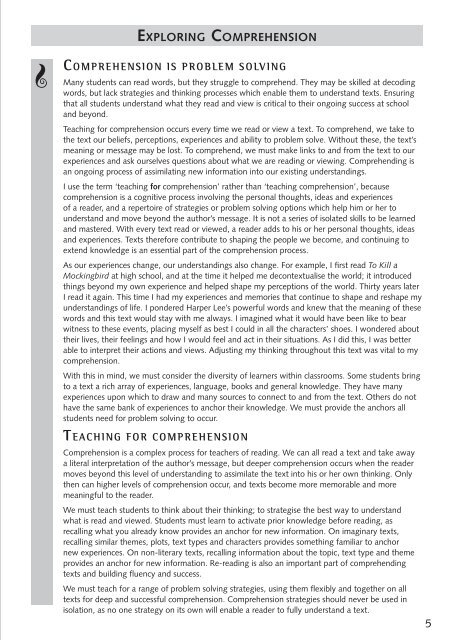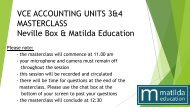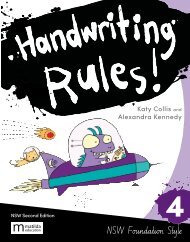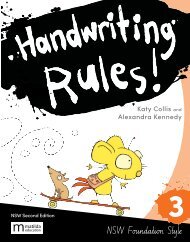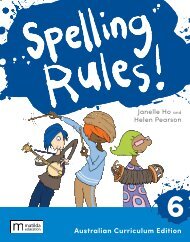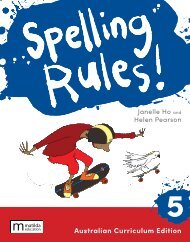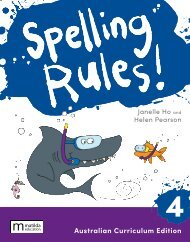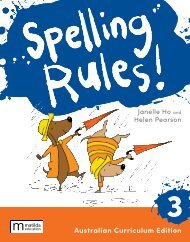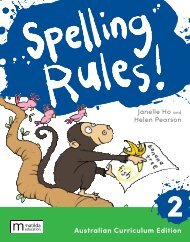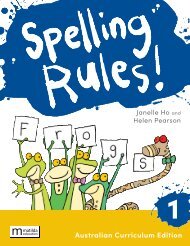All You Need To Teach Comprehension 10+
Create successful ePaper yourself
Turn your PDF publications into a flip-book with our unique Google optimized e-Paper software.
Exploring <strong>Comprehension</strong><br />
C o m p r e h e n si o n is proble m solv i n g<br />
Many students can read words, but they struggle to comprehend. They may be skilled at decoding<br />
words, but lack strategies and thinking processes which enable them to understand texts. Ensuring<br />
that all students understand what they read and view is critical to their ongoing success at school<br />
and beyond.<br />
<strong>Teach</strong>ing for comprehension occurs every time we read or view a text. <strong>To</strong> comprehend, we take to<br />
the text our beliefs, perceptions, experiences and ability to problem solve. Without these, the text’s<br />
meaning or message may be lost. <strong>To</strong> comprehend, we must make links to and from the text to our<br />
experiences and ask ourselves questions about what we are reading or viewing. Comprehending is<br />
an ongoing process of assimilating new information into our existing understandings.<br />
I use the term ‘teaching for comprehension’ rather than ‘teaching comprehension’, because<br />
comprehension is a cognitive process involving the personal thoughts, ideas and experiences<br />
of a reader, and a repertoire of strategies or problem solving options which help him or her to<br />
understand and move beyond the author’s message. It is not a series of isolated skills to be learned<br />
and mastered. With every text read or viewed, a reader adds to his or her personal thoughts, ideas<br />
and experiences. Texts therefore contribute to shaping the people we become, and continuing to<br />
extend knowledge is an essential part of the comprehension process.<br />
As our experiences change, our understandings also change. For example, I first read <strong>To</strong> Kill a<br />
Mockingbird at high school, and at the time it helped me decontextualise the world; it introduced<br />
things beyond my own experience and helped shape my perceptions of the world. Thirty years later<br />
I read it again. This time I had my experiences and memories that continue to shape and reshape my<br />
understandings of life. I pondered Harper Lee’s powerful words and knew that the meaning of these<br />
words and this text would stay with me always. I imagined what it would have been like to bear<br />
witness to these events, placing myself as best I could in all the characters’ shoes. I wondered about<br />
their lives, their feelings and how I would feel and act in their situations. As I did this, I was better<br />
able to interpret their actions and views. Adjusting my thinking throughout this text was vital to my<br />
comprehension.<br />
With this in mind, we must consider the diversity of learners within classrooms. Some students bring<br />
to a text a rich array of experiences, language, books and general knowledge. They have many<br />
experiences upon which to draw and many sources to connect to and from the text. Others do not<br />
have the same bank of experiences to anchor their knowledge. We must provide the anchors all<br />
students need for problem solving to occur.<br />
T each i n g for co m p r e h e n si o n<br />
<strong>Comprehension</strong> is a complex process for teachers of reading. We can all read a text and take away<br />
a literal interpretation of the author’s message, but deeper comprehension occurs when the reader<br />
moves beyond this level of understanding to assimilate the text into his or her own thinking. Only<br />
then can higher levels of comprehension occur, and texts become more memorable and more<br />
meaningful to the reader.<br />
We must teach students to think about their thinking; to strategise the best way to understand<br />
what is read and viewed. Students must learn to activate prior knowledge before reading, as<br />
recalling what you already know provides an anchor for new information. On imaginary texts,<br />
recalling similar themes, plots, text types and characters provides something familiar to anchor<br />
new experiences. On non-literary texts, recalling information about the topic, text type and theme<br />
provides an anchor for new information. Re-reading is also an important part of comprehending<br />
texts and building fluency and success.<br />
We must teach for a range of problem solving strategies, using them flexibly and together on all<br />
texts for deep and successful comprehension. <strong>Comprehension</strong> strategies should never be used in<br />
isolation, as no one strategy on its own will enable a reader to fully understand a text.<br />
5


